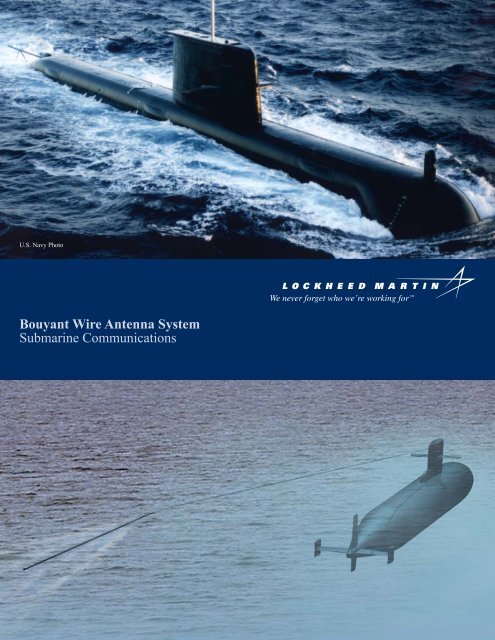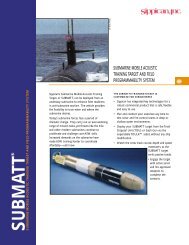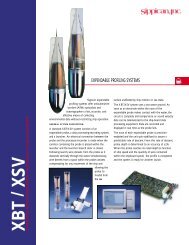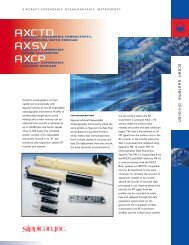Buoyant Wire Antenna (BWA) System
Buoyant Wire Antenna (BWA) System
Buoyant Wire Antenna (BWA) System
Create successful ePaper yourself
Turn your PDF publications into a flip-book with our unique Google optimized e-Paper software.
U.S. Navy Photo<br />
Bouyant <strong>Wire</strong> <strong>Antenna</strong> <strong>System</strong><br />
Submarine Communications
<strong>Buoyant</strong> <strong>Wire</strong> <strong>Antenna</strong> <strong>System</strong><br />
Submarine Communications<br />
HF<br />
HF<br />
VLF/LF<br />
MF/HF<br />
In today’s environment of combined operations<br />
and Network Centric Warfare (NCW) concepts, the ability<br />
of submarines to communicate over a wide range of operating<br />
postures has become increasingly important. Modern submarines<br />
are required to receive messages from their home base, and on<br />
occasion, are required to communicate with surface ships and<br />
aircraft. This must be accomplished while the submarine remains<br />
undetected with minimal negative impact on mission priorities<br />
and effectiveness. In addition, the introduction of Air<br />
Independent Propulsion (AIP) into submarines and the<br />
embracement of Network Centric Warfare by most navies<br />
has elevated the requirement that today’s submarines have<br />
the ability to communicate from below periscope depth. These<br />
tactical concerns present a difficult challenge to a submarine<br />
commander given that presently most conventional submarines<br />
throughout the world’s navies must come to periscope depth<br />
and raise a mast or whip antenna to receive or transmit<br />
messages. Periscope depth operations are generally more<br />
perilous, crew stressing and difficult than operations at depth<br />
due to increased risk of detection, surface traffic, depth keeping<br />
requirements, and sea state effects. Also, since a line source<br />
presents the optimum geometry for return signals to surfacesearch<br />
or fire-control radars, employment of the vertical mast<br />
or whip antenna puts the submarine in a condition of significant<br />
vulnerability.<br />
Lockheed Martin has developed a complete line<br />
of <strong>Buoyant</strong> <strong>Wire</strong> <strong>Antenna</strong> <strong>System</strong>s designed to meet this<br />
challenge. <strong>Buoyant</strong> <strong>Wire</strong> <strong>Antenna</strong> (<strong>BWA</strong>) <strong>System</strong>s provide<br />
the submarine the capability of receiving in the VLF/LF/MF/<br />
HF (10 kHz - 35 MHz) communication band while remaining<br />
fully submerged. In addition, it is also possible to configure a<br />
<strong>BWA</strong> system for reception at VHF and the lower UHF bands<br />
and transmission in the 2 - 10 MHz band.<br />
In-Line Amplifier —<br />
Actual Size<br />
<strong>Buoyant</strong> <strong>Wire</strong> <strong>Antenna</strong> <strong>System</strong>s<br />
provide the submarine the capability<br />
to communicate from below periscope<br />
depth.<br />
<strong>Buoyant</strong><br />
<strong>Wire</strong> <strong>Antenna</strong><br />
<strong>Buoyant</strong> <strong>Wire</strong> <strong>Antenna</strong> <strong>System</strong>s are comprised of three<br />
major components: the <strong>Buoyant</strong> <strong>Wire</strong> <strong>Antenna</strong>, a Deployment<br />
<strong>System</strong> and an <strong>Antenna</strong> Coupler.<br />
The standard <strong>Buoyant</strong> <strong>Wire</strong> <strong>Antenna</strong> is either 610 m<br />
or 730 m in length, depending on the variant of Deployment<br />
<strong>System</strong> in use, with a diameter of 16.5 mm. Shorter and longer<br />
antenna lengths are also available. The standard antenna incorporates<br />
an in-line amplifier which operates in the frequency range<br />
of 2 MHz to 35 MHz; other versions provide operation below<br />
and beyond the 2 MHz - 35 MHz range.<br />
The Deployment <strong>System</strong> consists of an antenna winch<br />
and associated winch control apparatus. Using the winch control<br />
equipment, a single operator can command the winch to pay out<br />
the antenna, hold the antenna while it is being towed and retrieve<br />
the antenna. Deployment, tow and retrieval of the buoyant wire<br />
antenna can be conducted at a wide range of submarine speeds<br />
and at depths in excess of 400 m. With the complete scope<br />
of the standard antenna deployed, a submarine is capable of<br />
carrying out communication at depths in excess of 125 m.<br />
Upon completion of communications, the antenna may be<br />
completely recovered or remain deployed without adverse<br />
impact to submarine operations.<br />
Two types of Deployment <strong>System</strong>s can be provided:<br />
an electrically driven winch located outboard of the pressure<br />
hull and controlled by inboard electronic units or a hydraulically<br />
driven winch located inboard of the pressure hull and controlled<br />
by manually operated hydraulic valves.<br />
A special <strong>Antenna</strong> Coupler is required with <strong>Buoyant</strong><br />
<strong>Wire</strong> <strong>Antenna</strong>s. This coupler contains unique antenna impedance<br />
matching circuits, low noise amplifiers for improved system<br />
sensitivity, power supplies to power the in-line antenna amplifier<br />
and 50 ohm output drivers. The <strong>Antenna</strong> Coupler allows<br />
standard, VLF-HF communication receivers to operate with the<br />
<strong>Buoyant</strong> <strong>Wire</strong> <strong>Antenna</strong>.
Lockheed Martin has developed a<br />
complete line of <strong>Buoyant</strong> <strong>Wire</strong> <strong>Antenna</strong><br />
<strong>System</strong>s, for both modern diesel electric<br />
and nuclear powered submarines.<br />
Inboard Deployment <strong>System</strong><br />
For larger new construction submarines or where space is<br />
Inboard<br />
available on existing submarines, Lockheed Martin offers an<br />
Deployment<br />
inboard deployment system for buoyant wire antennas. This system is<br />
<strong>System</strong><br />
backed by more than 30 years of successful operation beneath the oceans<br />
of the world. Hydraulically operated, the inboard deployment system operates<br />
over a wide range of deployment/retrieval speeds and can be tailored to match the<br />
capacity of the available ship hydraulic system. The inboard deployment system<br />
offers an advantage over the outboard system, in that the equipment is accessible<br />
by the crew while the submarine is submerged, thus allowing different antenna<br />
types to be streamed from the submarine without having to surface.<br />
Outboard<br />
Deployment<br />
<strong>System</strong><br />
Winch<br />
Drive Unit<br />
Winch<br />
Control Unit<br />
Outboard Deployment <strong>System</strong><br />
For retrofit on existing submarines, or for new designs with limited interior space,<br />
Lockheed Martin offers a unique and highly compact outboard deployment system for<br />
buoyant wire antennas. The deployment system can be customized to fit in the forward<br />
or aft end of the fin or located beneath the submarine superstructure. Inaccessible while<br />
submerged, the outboard deployment system is designed to ensure high reliability,<br />
high survivability, low-noise operation and to withstand the harsh ocean environment.<br />
This is accomplished through the use of direct drive, ultra quiet brushless DC motors,<br />
corrosion resistant materials, and complex shock mounting systems. The outboard<br />
system is remotely operated from within the submarine, powered from a DC and/or<br />
AC power bus and operates over a wide range of deployment/retrieval speeds.<br />
An integral and essential part<br />
to any buoyant wire antenna system is<br />
the antenna coupler. Modern, state-of-theart<br />
buoyant wire antenna couplers utilize<br />
sophisticated electronic circuitry designed<br />
specifically to allow proper interface<br />
between the outboard antenna assemblies<br />
and inboard communication receivers<br />
The uncompensated amplitude<br />
and phase response of a buoyant wire are<br />
a complex function of frequency. Further,<br />
the lower level signals captured by the<br />
antenna are attenuated by the outboard<br />
transmission line which routes the<br />
antenna signals inboard. It is therefore<br />
necessary that appropriate amplitude and<br />
phase compensation circuits be employed<br />
and that the front end utilize extremely<br />
low noise preamplifiers. In addition it<br />
is necessary for the coupler to employ<br />
highly specialized, very low noise power<br />
supply circuits which multiplex DC<br />
<strong>Buoyant</strong> <strong>Wire</strong> <strong>Antenna</strong> Coupler<br />
power onto the same transmission line<br />
to operate the outboard in-line amplifiers<br />
of the buoyant wire antenna assembly.<br />
Lockheed Martin has done<br />
extensive research leading to the<br />
development of a range of <strong>Buoyant</strong><br />
<strong>Wire</strong> <strong>Antenna</strong> Couplers. These multiband/multimode<br />
couplers allow for the<br />
use of certain buoyant wire antennas<br />
for reception of signals from 10 kHz<br />
to 35 MHz, and with other antennas,<br />
for reception at higher frequencies and<br />
transmission in the HF band.<br />
This equipment has been carefully<br />
designed to operate compatibly in<br />
the submarine radio room environment.<br />
They meet the EMI/EMC requirements<br />
of MIL-STD-461 and the environmental<br />
requirements generally imposed for<br />
submarine equipments.
©2006<br />
Lockheed Martin Corporation<br />
All Rights Reserved<br />
Lockheed Martin MS2<br />
Seven Barnabas Road<br />
Marion, MA 02738<br />
An ISO9001:2000 Company<br />
Sea-Air <strong>System</strong>s<br />
508.748.1160 (x138)<br />
e-mail: douglas.Q.williams@lmco.com<br />
OCT2006/NDCR/20060008/Covers:2006
















